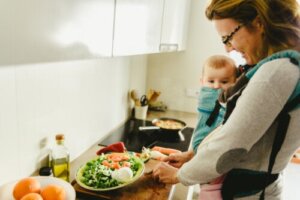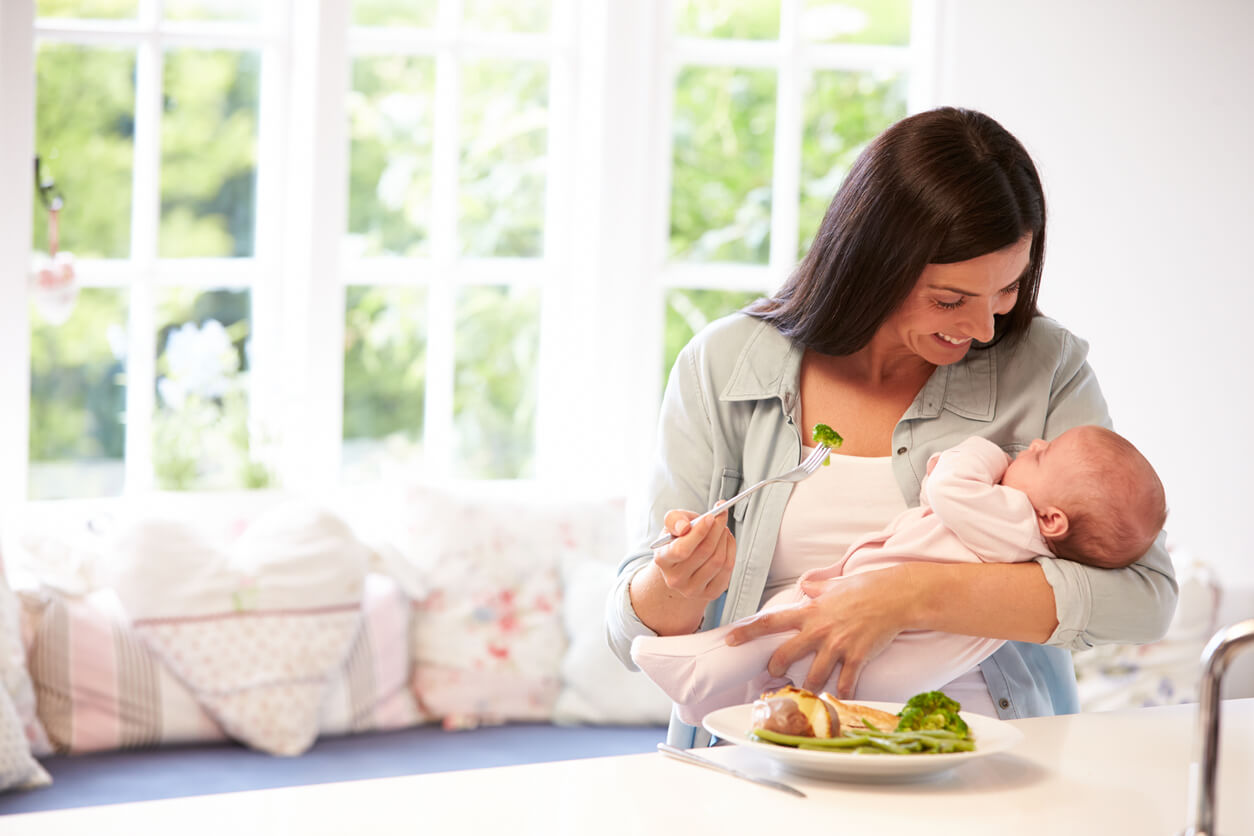What to Eat During the Postpartum Period

“Now that I’ve had my baby, I want to eat everything in sight!” This is a common phrase heard after a natural childbirth or cesarean section. But it’s important to keep your appetite in check because right now is when you must continue to take care of your health, your body, and, of course, the protagonist of the story, your baby. So what should you eat in the postpartum period?
The answer merits some reflection. For example, when breastfeeding your baby, what you eat will affect them for better or worse. In addition, postpartum is loaded with emotional, physiological, and physical changes, for which you need an adequate, balanced, and varied diet. In this article, we’ll give you everything you need to know to recover quickly and safely during the first 40 days after the birth of your baby.
What does the postpartum period refer to and how is it classified?
To be clear, the postpartum stage is known as puerperium or quarantine. It refers to the period after childbirth in which the body gradually returns to the physical and functional state it had before pregnancy.
This stage lasts between 35 and 40 days, although for some specialists, it culminates when the first menstruation appears, which could be at 60 days. Depending on the time, the postpartum period is classified as follows:
- Immediate puerperium: This is the stage that covers the first 24 hours after delivery.
- Mid-term postpartum: This ranges from day 2 to day 10.
- Distant puerperium: This ends at 40 days.
- Late Puerperium: This period can extend up to 364 days after delivery, as not all organs return to their natural state after 60 days.

The plan for what to eat during the postpartum period will depend on the stage of the puerperium and the type of delivery, as there are some specific recommendations for natural childbirth and others for cases of cesarean section.
What should you eat during the postpartum period?
The first thing to keep in mind are the objectives that a postpartum eating plan should meet. These are the following:
- Achieving a quick recovery
- Avoiding abdominal distension
- Avoiding infections in case of cesarean section and facilitating good healing
- Supporting breastfeeding through an adequate diet
Diet for natural or vaginal delivery
During the first 2 hours of the immediate postpartum period, a liquid diet should be started to test tolerance to intake. For example, new moms can drink chamomile tea, apple juice, water, or fat-free chicken broth. In the following 24 hours, if everything has been well tolerated, they can continue with a soft diet, such as mashed sweet potato, potato, cream soup, fruit puree, natural ice cream, yogurt, and chopped or ground chicken.
In the immediate and distant puerperium, a normal diet can be maintained, and it should be as possible, due to the physiological condition in which the mother finds herself. Therefore, the following foods should be incorporated:
- Fresh fruits and vegetables, such as spinach, broccoli, watercress, Swiss chard, peppers, onions, turnip, zucchini, pumpkin, pumpkin, apple, melon, cantaloupe, peach, mango, kiwi, strawberries, blueberries, eggplant, and tomato, among others
- Lean proteins, such as chicken, oily fish, eggs, and low-fat dairy products
- Healthy fats, such as olive oil, corn, soybean, sunflower, canola, and avocado
- Nuts
- Whole grains
Diet for cesarean delivery
Cesarean section is a major abdominal surgical procedure that requires dietary rest for several hours. That is, during the immediate postpartum period, it’s best not to ingest any food, but only sips of water as tolerated until sufficient quantities are reached to keep the mother well hydrated.
Liquids
However, some OB-GYN surgeons recommend starting the tolerance between 8 and 16 hours after the cesarean section, when you’re sure that there will be no complications. If everything is going well, before the end of the first 24 hours, a chamomile tea, pear or apple juice, gelatin, or fat-free broth can be ingested. The ingestion of liquids will help in the production of milk for breastfeeding.

Solid foods
From now on, the foods to include are the same as for natural childbirth. But during the recovery process from surgery, foods that facilitate healing and prevent infection should be selected. For example, it’s crucial to maintain an adequate protein quota based on chicken, egg whites, fish, and nuts.
In addition, the energy requirement must be met to cover the extra demand for healing. For this, foods that are sources of carbohydrates are included, such as whole grains, tubers, and fruits, which will provide sugar for rapid assimilation.
As Miren Begoña’s work points out, the intake of vitamin A, vitamin C, iron, and zinc, which will help the body to repair damaged tissue and increase the body’s defenses, should also be ensured. For this reason, experts recommend eating more fruits and vegetables, such as pumpkin, melon, carrots, broccoli, peppers, spinach, arugula, watercress, animal foods, and seeds.
What you must comply with during the postpartum period
In order to ensure the good health of both mother and baby, it’s advisable to comply with a series of guidelines. Namely:
- The diet be distributed in several portions, at least 6 times a day, instead of 3 large meals.
- Select healthy snacks between meals. For example, cottage cheese, fruits, mixed nuts, granola bars, peanut butter, apple slices, and yogurt, among others.
- Also include foods that help strengthen the immune system.
- Promote the consumption of iron and B complex vitamins, which will help energy metabolism. This way, the extra calories demanded by breastfeeding are provided.
- During lactation, avoid legumes, such as beans, lentils, chickpeas, or peas, among others. Some vegetables such as cabbage, cauliflower, asparagus, and lettuce should also be limited, as they can cause flatulence and colic in the baby.
- Don’t consume alcoholic beverages, tobacco, sweets, and table sugar.
- Restrict ultra-processed foods or allergens such as canned foods, tuna, citrus, and peanuts, among others.
- Consult a professional. Remember that what you eat will also feed the baby, so it’s key to consult with a nutritionist to select the right foods.
What you need to know
What you eat during the postpartum period should be guided by a nutrition professional, as certain goals must be achieved to allow the mother to recover quickly. It’s not a matter of taking things lightly, as foods must be carefully selected. Therefore, your diet should be balanced, varied, and sufficient in terms of the quantity and quality required by your current physiological stage, that is, the breastfeeding stage.
Incorporating fresh fruits and vegetables rich in vitamins A and C, zinc and iron, healthy fats, lean proteins, skimmed dairy products, and whole grains, and distributing meals in at least 6 portions a day, are some of the premises to be taken into account.
“Now that I’ve had my baby, I want to eat everything in sight!” This is a common phrase heard after a natural childbirth or cesarean section. But it’s important to keep your appetite in check because right now is when you must continue to take care of your health, your body, and, of course, the protagonist of the story, your baby. So what should you eat in the postpartum period?
The answer merits some reflection. For example, when breastfeeding your baby, what you eat will affect them for better or worse. In addition, postpartum is loaded with emotional, physiological, and physical changes, for which you need an adequate, balanced, and varied diet. In this article, we’ll give you everything you need to know to recover quickly and safely during the first 40 days after the birth of your baby.
What does the postpartum period refer to and how is it classified?
To be clear, the postpartum stage is known as puerperium or quarantine. It refers to the period after childbirth in which the body gradually returns to the physical and functional state it had before pregnancy.
This stage lasts between 35 and 40 days, although for some specialists, it culminates when the first menstruation appears, which could be at 60 days. Depending on the time, the postpartum period is classified as follows:
- Immediate puerperium: This is the stage that covers the first 24 hours after delivery.
- Mid-term postpartum: This ranges from day 2 to day 10.
- Distant puerperium: This ends at 40 days.
- Late Puerperium: This period can extend up to 364 days after delivery, as not all organs return to their natural state after 60 days.

The plan for what to eat during the postpartum period will depend on the stage of the puerperium and the type of delivery, as there are some specific recommendations for natural childbirth and others for cases of cesarean section.
What should you eat during the postpartum period?
The first thing to keep in mind are the objectives that a postpartum eating plan should meet. These are the following:
- Achieving a quick recovery
- Avoiding abdominal distension
- Avoiding infections in case of cesarean section and facilitating good healing
- Supporting breastfeeding through an adequate diet
Diet for natural or vaginal delivery
During the first 2 hours of the immediate postpartum period, a liquid diet should be started to test tolerance to intake. For example, new moms can drink chamomile tea, apple juice, water, or fat-free chicken broth. In the following 24 hours, if everything has been well tolerated, they can continue with a soft diet, such as mashed sweet potato, potato, cream soup, fruit puree, natural ice cream, yogurt, and chopped or ground chicken.
In the immediate and distant puerperium, a normal diet can be maintained, and it should be as possible, due to the physiological condition in which the mother finds herself. Therefore, the following foods should be incorporated:
- Fresh fruits and vegetables, such as spinach, broccoli, watercress, Swiss chard, peppers, onions, turnip, zucchini, pumpkin, pumpkin, apple, melon, cantaloupe, peach, mango, kiwi, strawberries, blueberries, eggplant, and tomato, among others
- Lean proteins, such as chicken, oily fish, eggs, and low-fat dairy products
- Healthy fats, such as olive oil, corn, soybean, sunflower, canola, and avocado
- Nuts
- Whole grains
Diet for cesarean delivery
Cesarean section is a major abdominal surgical procedure that requires dietary rest for several hours. That is, during the immediate postpartum period, it’s best not to ingest any food, but only sips of water as tolerated until sufficient quantities are reached to keep the mother well hydrated.
Liquids
However, some OB-GYN surgeons recommend starting the tolerance between 8 and 16 hours after the cesarean section, when you’re sure that there will be no complications. If everything is going well, before the end of the first 24 hours, a chamomile tea, pear or apple juice, gelatin, or fat-free broth can be ingested. The ingestion of liquids will help in the production of milk for breastfeeding.

Solid foods
From now on, the foods to include are the same as for natural childbirth. But during the recovery process from surgery, foods that facilitate healing and prevent infection should be selected. For example, it’s crucial to maintain an adequate protein quota based on chicken, egg whites, fish, and nuts.
In addition, the energy requirement must be met to cover the extra demand for healing. For this, foods that are sources of carbohydrates are included, such as whole grains, tubers, and fruits, which will provide sugar for rapid assimilation.
As Miren Begoña’s work points out, the intake of vitamin A, vitamin C, iron, and zinc, which will help the body to repair damaged tissue and increase the body’s defenses, should also be ensured. For this reason, experts recommend eating more fruits and vegetables, such as pumpkin, melon, carrots, broccoli, peppers, spinach, arugula, watercress, animal foods, and seeds.
What you must comply with during the postpartum period
In order to ensure the good health of both mother and baby, it’s advisable to comply with a series of guidelines. Namely:
- The diet be distributed in several portions, at least 6 times a day, instead of 3 large meals.
- Select healthy snacks between meals. For example, cottage cheese, fruits, mixed nuts, granola bars, peanut butter, apple slices, and yogurt, among others.
- Also include foods that help strengthen the immune system.
- Promote the consumption of iron and B complex vitamins, which will help energy metabolism. This way, the extra calories demanded by breastfeeding are provided.
- During lactation, avoid legumes, such as beans, lentils, chickpeas, or peas, among others. Some vegetables such as cabbage, cauliflower, asparagus, and lettuce should also be limited, as they can cause flatulence and colic in the baby.
- Don’t consume alcoholic beverages, tobacco, sweets, and table sugar.
- Restrict ultra-processed foods or allergens such as canned foods, tuna, citrus, and peanuts, among others.
- Consult a professional. Remember that what you eat will also feed the baby, so it’s key to consult with a nutritionist to select the right foods.
What you need to know
What you eat during the postpartum period should be guided by a nutrition professional, as certain goals must be achieved to allow the mother to recover quickly. It’s not a matter of taking things lightly, as foods must be carefully selected. Therefore, your diet should be balanced, varied, and sufficient in terms of the quantity and quality required by your current physiological stage, that is, the breastfeeding stage.
Incorporating fresh fruits and vegetables rich in vitamins A and C, zinc and iron, healthy fats, lean proteins, skimmed dairy products, and whole grains, and distributing meals in at least 6 portions a day, are some of the premises to be taken into account.
All cited sources were thoroughly reviewed by our team to ensure their quality, reliability, currency, and validity. The bibliography of this article was considered reliable and of academic or scientific accuracy.
- Bezares B., Sanz O., Jiménez I.. Patología puerperal. Anales Sis San Navarra [Internet]. 2009 [citado 2023 Ene 11] ; 32( Suppl 1 ): 169-175. Disponible en: http://scielo.isciii.es/scielo.php?script=sci_arttext&pid=S1137-66272009000200015&lng=es.
- Guía de práctica clínica. Puerperio normal y patológico. 2021. Disponible en: https://www.sarda.org.ar/images/Guia_de_practica_clinica_de_puerperio_normal_y_patologico.pdf
- Miren Begoña. EL PAPEL DE LA NUTRICIÓN EN LA CICATRIZACIÓN DE LAS HERIDAS. Universidad del País Vasco. Trabajo de fin de grado, 2015. Disponible en: https://www.enfermeriaaps.com/portal/wp-content/uploads/2017/03/Papel-de-la-nutricion-en-la-cicatrizacion-de-las-heridas.pdf
- MedlinePlus. NIH. Dieta blanda. Disponible en: https://medlineplus.gov/spanish/ency/patientinstructions/000068.htm
This text is provided for informational purposes only and does not replace consultation with a professional. If in doubt, consult your specialist.








